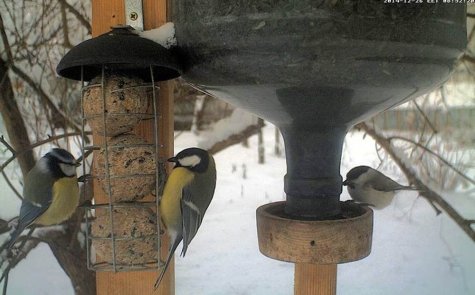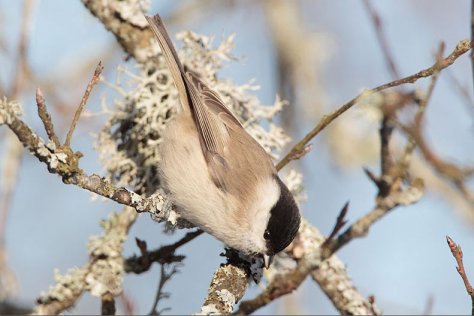Winter bird feeder camera – Marsh tit
Web camera image captured by Airras, LK forum
Photo Arne Ader
Translation Liis
Blue tit, great tit and marsh tit
Marsh tit Salutihane Parus palustris
The marsh tit's earlier name, sootihane, meant ”marsh tit” in Estonian too, but now it is called salutihane, ”shrub tit”. The willow tit is very similar to it but they can actually be told apart, it only needs some training.
Both birds above are the same size and weight as blue tits – length and weight of all is around a dozen centimetres and grams respectively.
The winter number is estimated at more than a hundred thousand individuals but in winter young birds have arrived here from the north as well as from east, and we can see them at times in small groups. Part of our young birds from this summer have in turn migrated up to a couple of hundred kilometres towards south.
Marsh tits are very sedentary birds throughout the year and their habitat is probably somewhere near the bird feeder. Your bird feeder too will probably be visited by one or two individuals during the whole winter. Towards people the birds are surprisingly trusting, you can train them to take food from your hand. The most vegetarian of all tits, when they get on to a fat ball it is more a question of finding a landing place.
They wait patiently for their turn at the feeding table in a nearby shrub or tree; it is only when the other, stronger and more aggressive, passerines leave that the turn of the marsh tits arrives. Sunflower seeds are quickly snatched, they fly away to hide it – and then back to queue up again – the marsh tits are store collectors. When there is a crowd at the feeding table the marsh tits peacefully enjoy already hidden stuff …
The plumage of the marsh tit is that of a ”grey-coat-man”, the wings (in winter) evenly brown. A large head, strong neck and on the head a black somewhat glossy beret hiding the eyes. Eyes dark brown, cheeks black, the little beard blackish and legs greyish blue. Both sexes wear similar costumes but the beret of young birds does not gleam yet.
Marsh tit observations: LINK
Marsh tit










